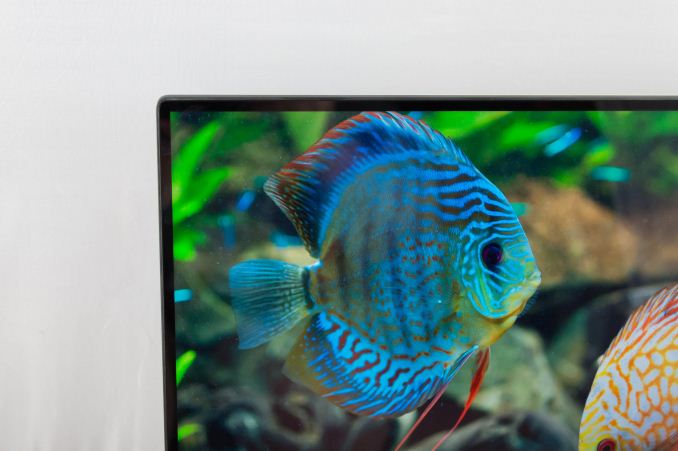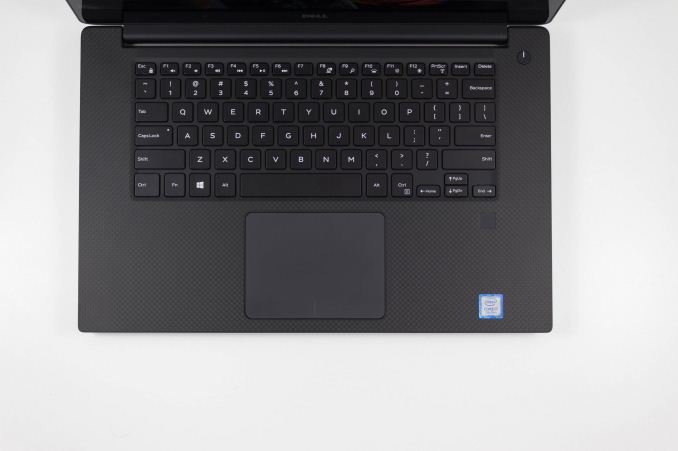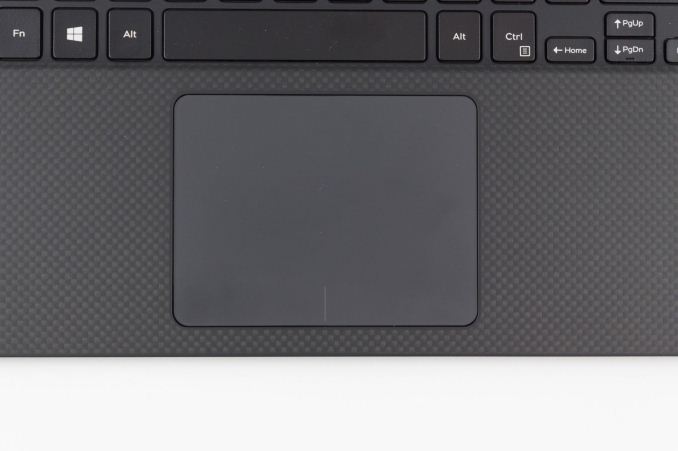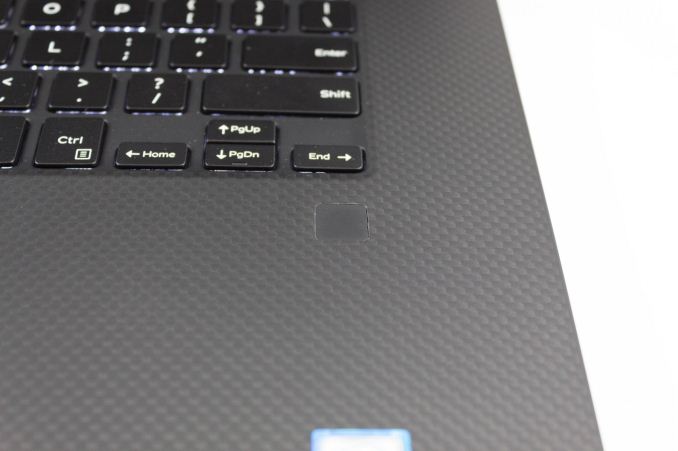The Dell XPS 15 9560 Review: Infinity Edge Part Two
by Brett Howse on July 31, 2017 8:00 AM ESTDesign
Dell already had one of the best designs for a notebook with the XPS 15 9550, so it is perhaps not a huge surprise to see them evolve that design only slightly for this year. It keeps the same thin-bezel design that has catapulted the XPS lineup into the distinctive look and feel they are known for today. Although the XPS 13 is more impacted by the thin bezels in percentage shrunk, Dell still offers the smallest 15.6-inch notebook around with the XPS 15.
Dell uses a machined aluminum top and bottom, and sandwiched in the middle is a carbon-fibre keyboard deck with a soft-touch coating. It makes the laptop very easy to use for extended periods of time, without the sharp edges that some all-metal laptops suffer from, but the coating can be a bit of a fingerprint magnet.
The keyboard is backlit in white, with multiple levels of brightness. It features a six row keyboard too, and without the extra width allowed by wider bezels, Dell doesn’t try to squeeze in a number pad, which is the right decision. Even on larger 15.6-inch laptops, that can make for a pretty cramped keyboard experience, with oddly placed keys. The XPS 15 features a fairly typical keyboard arrangement, with perhaps only the half-height arrow keys being a concern for some typists, although they are well spaced and shouldn’t pose much of an issue even for the pickiest of keyboard users.
The key travel itself is a bit disappointing. It features 1.3 mm of travel, which is likely due to the lack of space inside to offer a thicker keyboard. The keys don’t have the reassuring click sound either, with a more muted, mushy feel. We’ve been spoiled by some great laptop keyboards over the last couple of years, and the XPS 15 can’t reach that lofty goal. As with anything, a person would get used to it over time, but there are better keyboards out there.
The trackpad is smooth, and generously sized. The width is much more traditional than some devices which have gone with the ultra-wide trackpads, and because of this it feels more natural. There’s less hitting your palms on the trackpad too.
New to the XPS 15 9560, and tucked over on the right side of the keyboard deck, is a capacitive fingerprint reader. With Windows Hello integration, this gives you the option of using biometrics as a logon choice. The fingerprint reader is very responsive and has almost never missed a finger in the time here. Some people prefer the tactile feel of a fingerprint reader over a facial-recognition login method, but regardless, it’s nice to have at least one Windows Hello biometric option to speed up login.
The right side features the SD card reader, USB 3.0 with PowerShare, and a battery gauge indicator. The left side has the charging port, another USB 3.0 with PowerShare, full sized HDMI 1.4, a headset jack, and the Thunderbolt 3 connector. Other laptops may have more USB ports, but two A ports are generally enough for most people, and those that need more can easily tap into the USB-C port for far more bandwidth if necessary.
It's hard to say more about the XPS lineup at this point, since it’s become such a well-known design in the last couple of years. If you’ve not had a chance to see one in person, it’s probably worth a look. The smaller bezels really do reduce the bulk of the notebook, with the one downside in Dell’s case of a poorly positioned webcam at the bottom of the display. Dell wants to keep the top and side bezels the same size for aesthetics, and heavy webcam users will not appreciate this, with a less than flattering up-the-nose result. Since the launch of the Infinity Display, other manufacturers have done thin bezels, but with a thicker top bezel to allow space for the webcam. Not everyone uses the built-in webcam though, so whether this is an issue to anyone will be up to them.
Regardless, the XPS 15 is still one of the most striking large form factor laptops around, and Dell has managed to make it a compact device without lowering it to Ultrabook levels of performance.
















82 Comments
View All Comments
coolhardware - Monday, July 31, 2017 - link
What size SSD did you get? I have been eyeing the 1TB SSD version on Amazon http://amzn.to/2uRxsOk (url shortened) but I can't quite justify the price :-(Good call on replacing the Killer NIC with an Intel 8265. There are few things worse on laptop than than flaky wifi!
skavi - Tuesday, August 1, 2017 - link
Get a smaller SSD and upgrade it yourself. Dell makes it really easy, and you'll end up with a faster and probably cheaper solution, especially if you go through the process of selling the included drive.MarkZ3 - Monday, July 31, 2017 - link
A review of the MacBook Pro 15 would be great for comparison purposes! Anandtech hasn't done one in a while.tipoo - Monday, July 31, 2017 - link
Someone said on twitter it was in the works, there was just a lot else on schedule first. Not sure what the ETA is.Laxaa - Monday, July 31, 2017 - link
I've read that the 9560 is plagued with a lot of issues, like coil whine, keyboard blacklighting not working, faulty drivers and so on. Have you noticed issues with your sample, Brett? The stories are kind of off-putting.James5mith - Monday, July 31, 2017 - link
I haven't had any issues with mine. A friend also bought one, and mentioned his right side shift key was not responsive and he got it replaced quickly without much issue.Mine seems fine. No coil whine, and back lights are just fine for both screen and keyboard. Initially the driver for the nVidia was borked, but they released a new one two weeks after I received the laptop and since then it's been fine.
Laxaa - Monday, July 31, 2017 - link
A friend of mine had issues with his 9550, but he got a on-site motherboard replacement and it seems to work fine now.The reason I'm asking about faulty deivces is because I'm in the market for a new laptop and so far, the MBP seem sike a better choice based on reliability. However, there's the issue of the Mac beeing worth $1000 more.
Manch - Monday, July 31, 2017 - link
I bought the ASUS zenbook, my friend got the XPS 15. I wanted a numpad but had to give up on upgradeability of the ram as only one stick can be replaced so max 24GB for me. Performance wise they're identical. He got it bc the MBP lack of ports and everything soldered on. Uses a Samsung T1 SSD to keep a copy of OSX on it and runs it virtualized. Best of both worlds and def fast enough that its not an issue. Just an option to save you some $$$tipoo - Monday, July 31, 2017 - link
Afaik they're both at the same standard electronics failure rates. As for coil whine and such, get replacements in early if it happens. Otherwise I wouldn't rule the XPS out for reported issues - remember for every complaint there's probably many more users who don't have the problem.I havn't really had issue with Dell support either, though some complain about them.
Morawka - Monday, July 31, 2017 - link
and this is why you buy dell instead of Asus or even Acer. On-site motherboard replacement.. It's on-site for any repair almost.